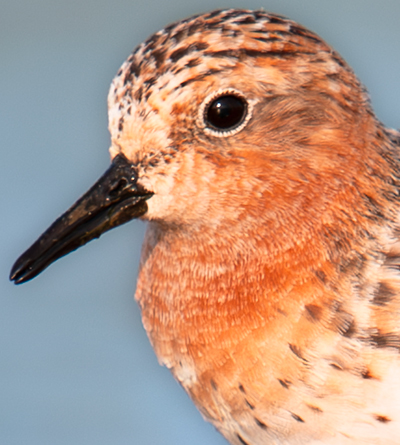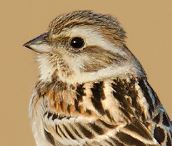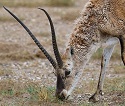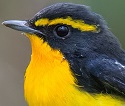Editor’s note: Jan-Erik Nilsén was one of the most successful of the birder-businessmen who operated in China during the Chinese Economic Miracle. While holding an executive position at a major multinational company, Jan-Erik spent his free time birding, first around Beijing, then throughout China. Despite birding only part time, Jan-Erik approached a scientist’s level of accomplishment. Jan-Erik’s meticulous records of shorebirds on the coast of the Bohai Sea earned praise from the world’s greatest ornithologists. Written exclusively for shanghaibirding.com, this four-post series is a valuable record of the achievements and observations of a great birder, and my great friend. Hyperlinks to species connect to entries in my Photographic Field Guide to the Birds of China, published in its entirety on shanghaibirding.com. For a tour to the locations mentioned in this series, write to tours@shanghaibirding.com. — Craig Brelsford
by Jan-Erik Nilsén
for shanghaibirding.com

In 2008 I accepted a job in Beijing that was to last six months. I ended up working there 12 years. Why did I stay so long? Partly because of my job, and probably even more so because the birding in China is fascinating. In this series, which includes this post and three others, I shall describe for you the sites, seasons, and species that thrilled me the most.
What makes birding in China so good? Look at the geography. Many bird species familiar to Europeans are not exclusively European at all, but Eurasian. Two very different habitat belts—the trans-Eurasian forest zone and the Eurasian Arctic—stretch more or less unbroken across the northern part of the supercontinent into China, distributing species throughout their breadth. Among the many species whose ranges span the supercontinent are several species of duck, other anatids such as Tundra Bean Goose, Greylag Goose, and Tundra Swan, and raptors such as Eurasian Sparrowhawk, Hen Harrier, and White-tailed Eagle. Add a number of waders to the list, plus passerines such as Great Tit, Eurasian Jay, and Red-throated Pipit.
Over the Central Asian steppes and arid landscapes, another band of species reaches from Europe to China, among them Ruddy Shelduck, Ferruginous Duck, Chukar Partridge, Long-legged Buzzard, Pallas’s Gull, Eurasian Skylark, and Lesser Whitethroat.
Genera found in Europe and Central Asia, among them the redstarts (Phoenicurus) and rosefinches (Carpodacus), occur also in China, which adds several species, notably on the Tibetan Plateau.

As one moves east, toward and finally along the Pacific coast, one encounters species confined to eastern Eurasia. Perhaps most notable among them are those East Asian waders that in Europe are rarities much sought after: Red-necked Stint, Little Curlew, Sharp-tailed Sandpiper, Great Knot. One finds also anatids such as Falcated Duck, Mandarin Duck, and Swan Goose, and passerines such as Brown Shrike, Tiger Shrike, Eastern Crowned Warbler, Black-faced Bunting, and Yellow-browed Bunting.
South of the Tibetan Plateau we find the jungle-like forests of the Himalayas and Yunnan, introducing several new groups of birds, rich in species and unfamiliar to a birder whose experience has been confined to Europe: laughingthrushes, parrotbills, yuhinas, and fulvettas, among several others. The geographic puzzle of the Chinese bird fauna is finally completed with a set of bird species in common with Southeast Asia and India: several cuckoos, cuckooshrikes, even more laughingthrushes, and a horde of babblers.
Note also that in China several genera and families that occur in Europe are also represented, but in China by a higher number of species. Among these are the cranes, cuckoos, woodpeckers, robins, leaf warblers, grass warblers, marsh and reed warblers, and bullfinches, plus the aforementioned redstarts and rosefinches. For many of these groups, the place with the highest concentration of species is the Himalayas and its connected mountain ranges. It is as if a centrifugal force were flinging species out of a Himalayan epicenter to the rest of Eurasia.
The number of species of bird in China is large. As of October 2024, eBird lists 1,371 species for China, 52 percent more than the 903 species listed for Europe. The areas of the two landmasses are approximately the same.
While Western Europe and Scandinavia have been thoroughly birded, birding is still new to China and holds more surprises. The size of the Chinese landmass and its amazing variety of habitats offer an endless array of good birding sites and birding experiences.
In this series, I will take you to my favorite regions and relate to you some of my most memorable adventures birding in China. Refer to the index below and read about my experiences in Beijing, where I was based; in China’s arid interior; and on China’s coast.
The Thrill of Birding in China (Introduction) (you are here)

• The Thrill of Birding in Beijing: Expanding far beyond its urban core, the city-province of Beijing includes mountains, plains, lakes, and reservoirs. Miyun Reservoir delivers White-naped Crane and Jankowski’s Bunting, while the mountains hold East Asian classics Zappey’s Flycatcher and Grey-sided Thrush.

• The Thrill of Birding China’s Arid Interior: Inner Mongolia, Qinghai, and Xinjiang offer unmatched opportunities to birders. Near the Argun River in northern Inner Mongolia, I had Baikal Teal and Blyth’s Pipit, in Qinghai I found high-altitude specialist Güldenstädt’s Redstart and amazing mammals such as Tibetan Antelope, and in Xinjiang I ticked Central Asian specialties Red-fronted Serin and Eversmann’s Redstart.

• The Thrill of Birding Shanghai and the Bohai Sea Coast: Shanghai’s Cape Nanhui showed me an astonishing number of East Asian migrants, among them Japanese Yellow Bunting and Narcissus Flycatcher. Nearer my home in Beijing, the Bohai Sea coast gave me waders and gulls by the thousands, plus rarities Nordmann’s Greenshank and Spoon-billed Sandpiper.
Featured image: Jan-Erik Nilsén scans Xinjiang’s Ulungur Lake (47.339970, 87.553458), one of dozens of bird-rich and imperfectly understood areas that the ace birder discovered during his 12-year sojourn in China. “[B]irding is still new to China and holds more surprises,” writes Nilsén. “The size of the Chinese landmass and its amazing variety of habitats offer an endless array of good birding sites and birding experiences.” Join Nilsén on a four-post journey to the best birding areas in China. (Craig Brelsford)

